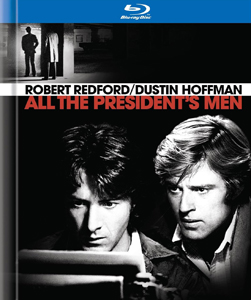The cycle of life imitating art imitating life comes full circle for director Alan J. Pakula with the capper to his thematic “paranoia trilogy,” “All the President’s Men” (1976). After returning noir to theaters with “Klute” (1971) and popularizing conspiracy noir with “The Parallax View” (1974), Pakula was the obvious choice to helm this cinematic adaptation of Carl Bernstein and Bob Woodward’s 1974 book that recounts their 1972-73 reporting of the Watergate scandal for the Washington Post.
I haven’t seen Pakula’s 1973 comedy “Love and Pain and the Whole Damn Thing,” but even if that’s a strikeout, we’re talking about three home runs in four at-bats – an incredible stretch of filmmaking.
Influential, but also timelessly compelling
The “paranoia trilogy,” and “President’s Men” in particular, then helped spawn “The X-Files” (and all that show has wrought). And we can’t help but think of it now when watching other accounts of reporters doing the hard work that brings out hidden truths, such as “Spotlight” (2015) and “The Post” (2017).

“All the President’s Men” (1976)
Director: Alan J. Pakula
Writers: William Goldman (screenplay), Carl Bernstein, Bob Woodward
Stars: Dustin Hoffman, Robert Redford, Jack Warden
Over three days, RFMC is looking back at the masterful and influential “paranoia trilogy” – “Klute” (1971), “The Parallax View” (1974) and “All the President’s Men” (1976).
We’re reminded how thin the line between homage and ripoff is when seeing Woodward (Robert Redford) talking to his source, Deep Throat (Hal Halbrook), in the shadows of a parking garage. Mulder would talk to his own Deep Throat in parking garages two decades later, and place an “X” symbol on his window to alert his source, similar to how Woodward places a red flag in his flower pot. In their first meeting, Woodward and Deep Throat even pause to notice “X-Files”-esque whistling in the distance.
Like “Klute” and “Parallax,” “President’s Men” is laced with grimy shots of the city – D.C. in this case, where some of the film was likewise shot. Chris Carter obviously adored all three films, but he could’ve been inspired by this one alone.
Many influential films lose their edge over the years, but that’s not the case here. “President’s Men” still holds us like a magnet, even if versatile and legendary screenwriter William Goldman basically gives us meat-and-potatoes daily scenes of the reporters (remarkably green at the time, considering they are now household names) doing their jobs.
A vibrant era of newspapers
As the newer employee, Woodward is relatively straight-laced and careful, whereas longer-haired Dustin Hoffman brings a jittery, passionate edge to Bernstein (“Is there anywhere you don’t smoke?” Woodward asks). Because sources are so terrified that their lives might be in danger, the reporters have to use a lot of language tricks to get information and confirmations.

Bernstein’s strategy of counting to 10 and having the source stay on the line if he has no problem with the accuracy of an upcoming story is perhaps the most famous. But another great sequence comes when Bernstein simply chips away at a former CREEP (the most apt acronym ever, for the Committee to Re-Elect the President) bookkeeper (Jane Alexander) in her living room. He’s not rude, but he’s persistent; she’s scared but doesn’t force him to leave. Painstakingly, he gets information out of her.
While its impact as a gripping drama has not faded in a half-century, “President’s Men” also stands as a wistful portrait of a bygone era. Pakula’s newsroom scenes are today a time capsule of a thriving newspaper, as well as the technical details of how the job was done – with typewriters and special paper that pre-measures the column widths, the first step in measuring the space for the printed product.
In an example of “the more things change, the more they stay the same,” Post editor Ben Bradlee (Jason Robards) notes that a poll has come out showing that most Americans have never heard the word “Watergate.” But the investigation did lead to the exposure of the government as a hotbed of corruption, culminating in Nixon’s resignation. Even the least dialed-in citizen probably knows of the only president to resign, so even if it’s in a smaller way than one might hope, this was an important historical event.
A seeping sense of paranoia
There’s a gut-wrenching aspect to the time capsule, too. Woodward and Bernstein get little help from government agency sources (in retrospect, because many are involved in the conspiracy, or “just following orders”), but they still manage to get to the truth. Some reporters are still like that, but most news organizations are not, because they don’t have the money or manpower. Some modern newspapers are outright un-journalistic, with zero reporters and straight-up printed press releases.
Unlike in the 2001-set “Spotlight,” about the Boston Globe’s exposing of the Catholic Church abuse cover-up, “President’s Men” has zero scenes about the paper’s finances. At one point, Bernstein travels to Miami for an in-person meeting with a source. And this is at a point where the Watergate scandal is not the Post’s top priority. While Bradlee sticks by his boys, he is cautious about the story the whole way (which is of course a mark of good editorship).
After “Parallax,” “President’s Men” is a relief, because the reporters expose the conspiracy, forcing official investigators to do the same. It’s a victory for truth, justice and what we’re told is the American way, and an apt way to cap off Pakula’s thematic trilogy. It mirrors the “Star Wars” trilogy, starting with a personal success story, then showing the bad guys winning, then showing the good guys winning.
But this isn’t a matter of coasting to the finish line. Paranoia gradually soaks into the film frame by frame, leading to a pivotal moment when Deep Throat says it has escalated to the point where lives are in danger. And then we get Gordon Willis’s great shot of the camera zooming in on a quick-turning Woodward, who thinks he’s being followed. Cut to a wide angle, and it’s actually a deserted nighttime D.C. street.
“All the President’s Men” is a conclusion, but also a grand story “to be continued” in “The X-Files” and various dark mystery streamers of today. And, of course, in real life.
Typewriter image by Markus Winkler from Pixabay

